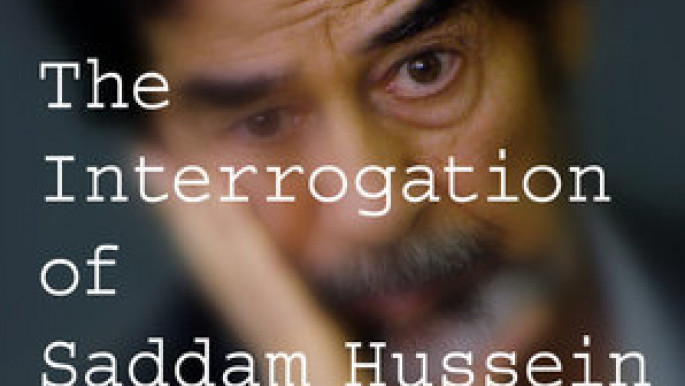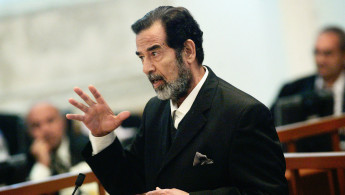Debriefing the President: The Interrogation of Saddam Hussein
Here was a man who ruled a country without mercy, who was well ahead of any coup attempt or mass insurrection against his rule.
Yet after the Americans came, he was on his own, a lone fugitive in his own country whose best place of refuge turned out to be a small hole in the ground. Why wasn't he in some secret bunker? Where was the complex labyrinth of secret tunnels and safe-houses the dictator could use to mount an extensive underground insurgency campaign against the American occupation?
These questions and many others were atop my mind when I picked up John Nixon's new book, Debriefing the President: The Interrogation of Saddam Hussein. Nixon was a CIA analyst who spent three years meticulously studying the Iraqi dictator before finally getting a chance to sit down with him.
He refers briefly to this famous episode, noting: "It was almost as though Saddam calculated that, if he didn't have a plan, his enemies wouldn't know where to look for him and his friends couldn't betray him."
Aside from its political musings, tying the events in the book - which now took place more than a decade ago - to the events of today, which I'll get to, Debriefing the President is a decent personal memoir about Nixon's experiences with Saddam, as well as an enjoyable light read.
Recounting how he studied and learned about the Iraqi dictator after joining the CIA as an analyst in the late 1990s, Nixon shows how his career essentially built up to these interviews.
"When you're a leadership analyst at the CIA, you're always at the remove," Nixon writes. "Saddam was a man I knew from photographs, from biographical anecdotes, from researching his family ties, from descriptions of Iraq defectors, from clandestine reports on his leadership style and autocratic excesses. Now he was sitting across from me."
 |
US officials took it as a foregone conclusion that Saddam would kill himself rather than be captured |  |
Early in the process, Nixon came to the astonishing conclusion that Washington "had never prepared for capturing Saddam alive".
"US officials took it as a foregone conclusion that Saddam would kill himself rather than be captured, or be killed as he tried to escape," he writes.
Saddam's capture, Nixon notes, was hugely significant. With the exception of the Panamanian dictator Manuel Noriega, the US had not captured and questioned a head of state since Hitler's successor at the end of the Second World War.
The debriefings themselves were quite extraordinary.
Saddam came out with remarkably self-delusional pronouncements, stemming from an apparent disapproval of his infamous personality cult. From "I didn't tell them to put up my picture everywhere," to "the Kurds lost their faith and trust in us", after the infamous gassing of 5,000 in Halabja.
 |
|
| [Penguin Random House] |
As Nixon notes on the latter statement: "What made this statement so bizarre was that Saddam said it in a mournful way, as though he couldn't quite understand why the Kurds got so upset with him."
Upon his departure, Saddam gave Nixon a warm parting statement, something the author noted he did not do with others who questioned him. Nixon writes that this might have been out of "some measure of respect for me because I had spent years studying him before we ever met", or simply because "the pesky guy who kept bringing up massacres and human rights abuses was finally going away".
The rest of Nixon's book deals with semi-related debriefings of then-President George W Bush and his subsequent time at the CIA. Bush once amusingly told him that both he and Muqtada al-Sadr had to contemplate being overshadowed by their fathers in their respective roles as leaders.
The book ends with an epilogue on Nixon's thoughts of Saddam's execution in late 2006 - the book being purposely released to coincide with the tenth anniversary of that execution.
"We had come to Iraq saying that we would make things better," Nixon writes. "We would bring democracy and the rule of law. No longer would people be awakened by a threatening knock on the door. And here we were, allowing Saddam to be hanged in the middle of the night."
In opening his book, Nixon says he hopes his work on the Iraqi leader would "help future historians strip away the mythology surrounding this complex man".
Aside from his political musings, the book is a fairly decent effort to examine the mind of Saddam and offers some insight into the man's post-capture mentality. Nixon's comparisons to current events in the Middle East, however, make the book feel more contemporary and are, perhaps, an effort on his part to connect events described in his book directly to the present, rather than let the events in it stand for themselves in their own time and context.
Indeed, in the very first sentence of his book, which follows a quote from Henry Kissinger, Nixon contends "the rise of Islamic extremism in Iraq, chiefly under the rubic of ISIS (or Islamic State in Iraq and al-Sham), is a catastrophe that the United States needn't have faced, had it been willing to live with an aging and disengaged Saddam Hussein".
Nixon points to the immediate power vacuum caused by Saddam's rapid removal and says the failure to implement a durable government in Baghdad resulted in the instability in the region with which we continue to grapple, from the Syrian Civil War to the infamous rise of the Islamic State group.
Nixon refuses to offer guesswork here: "Whether this chain of events would have taken place if Saddam, and possibly his successor, had remained in power is in the realm of counterfactual speculation."
Nixon insists that Iraq would have had a standing army had Saddam remained in place and he would have "used force to keep a lid on sectarian tensions in Iraq".
However, it's worth remembering that Iraq endured a crippling economic crisis in the 1990s, its infrastructure was wrecked by the 1991 Gulf War and its middle-class more-or-less eradicated by more than a decade of sanctions. How long, and at what cost, the regime could continue to rule over such an impoverished and desperate people was not clear.
 |
We had come to Iraq saying that we would make things better |  |
Nixon himself points out that Saddam was barely running the government and spent his time writing novels - not the preoccupation of a busy micro-managing head-of-state. He consequently concludes that Saddam was not worth removing from power, adding that one of his two sons, the notorious Uday or Qusay, might have succeeded him or "someone from the Sunni military-axis would have grabbed power through a coup".
"It wouldn't have been pretty, but at least it would have been an Iraqi solution to the question of 'Who leads Iraq?' The United States then could have re-engaged with the new regime," Nixon writes.
Here his speculation echoes that of the first Bush administration. After afflicting a costly defeat on Saddam's army in the Gulf War, Bush called on Iraqis to take matters into their own hands and overthrow the regime.
Washington naively believed that Saddam would be killed in a coup or uprising for losing the war in Kuwait. Instead, Saddam crushed simultaneous Kurdish and Shia uprisings - killing anywhere from 25,000 to 180,000 - and imposed a yet more harsh rule, having long prepared by rigorously insulating his regime against the threat of coups.
If another mass uprising began, had the 2003 invasion never happened, Iraq could have well imploded and suffered a fate not too dissimilar to Syria, if not much worse. This is an outcome which should not be discounted or unacknowledged by Nixon nor anyone else pondering the question "what if?"
The narrative that Saddam would have constituted some force for stability in the region had he been left in power has gained quite a bit of traction in the months preceding this book's release.
US President-elect Donald Trump has slammed the Iraq War on several occasions throughout his campaign, going so far as to say that Saddam at least "killed terrorists". Indeed a recent piece in The New Yorker goes so far as to argue that there is a direct correlation between the disenchantment in the US following Saddam's overthrow to the electoral victory of Trump.
Whether intentional or not, this is the prevailing political backdrop to Nixon's book debut. Unfortunately, he contributes a little too much to this current discourse rather than sticking to what his book's sole purpose should be: helping set the historical record on Saddam Hussein straight.
Paul Iddon is a freelance journalist based in Erbil, Iraqi Kurdistan, who writes about Middle East affairs.
Follow him on Twitter: @pauliddon



